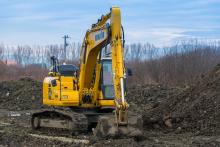
Data and analytics company GlobalData says that, supported by government investments on transport infrastructure projects to improve regional connectivity, the country’s construction industry is expected to regain growth momentum and expand this year. Despite the rising costs, the industry recorded a good start in 2022, with construction value expanding by 2.2% year-on-year (YoY) in the first quarter.
Danny Richards, lead economist at GlobalData, comments: “Following the growth in 2022, the German construction industry is expected to register an annual average growth of 1.8% from 2023 to 2026, supported by the government’s investment on infrastructure, residential and renewable energy projects."
However, he adds that the short-term outlook is subject to downside risk amid the fall-out from Russia’s invasion of Ukraine, which has weighed on investor confidence and further elevated energy and construction material prices.
The German government has revised its inflation forecast from 3.3% to 6.1% this year. Following Russia’s invasion of Ukraine, inflation rose to its highest level in 40 years in March 2022 as prices of natural gas and oil products surged. To help consumers cope with soaring energy costs and help Germany reduce its dependence on Russian gas, the government announced relief measures worth €16bn (US$19.1bn) in March 2022.
Richards says: “Despite the high material prices, the industry is expected to post growth in 2022 owing to significant planned investments, including most notably in the transportation and energy and utilities segments, in contrast to the contraction seen last year.
“The appointment of the Scholz government in December 2021 is also expected to facilitate growth in the industry, with their priorities including extending rent control policies, building 400,000 new apartments every year – including 100,000 social housing units – expanding renewable energy generation, strengthening public transport networks, and hiking the minimum hourly wage from under €10 (US$12.2) currently to €12 (US$14.6).”
In April 2022, the Federal Ministry for Economy and Climate Protection presented the coalition government’s ‘Easter Package’ for renewable energy, which revises various energy laws to expedite the expansion of renewable energy sources.
Forecast-period growth in the German construction industry will also be supported by investments on oil and gas projects, in line with the government’s plan to reduce its dependence on Russian imports.
As well as this, by 2030, Germany aims to nearly double the share of renewables in its total electricity consumption from 41.1% in 2020 to 80% by 2030. To achieve this target, onshore wind installations are targeted to rise by an average of 10GW per year, to reach a cumulative capacity of 115GW by the end of 2030, while the solar capacity is expected to rise by an average of 22GW per annum, to reach a cumulative capacity of 215GW by that year.
In May 2022, Germany’s federal cabinet gave an approval to draft a legislation for accelerating the construction of import terminals for Liquefied Natural Gas (LNG). The law will be applicable for floating and land-based LNG import terminals.










